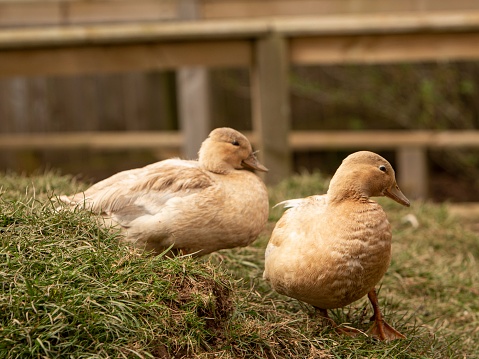Swedish Yellow Duck

Scientific Name
Anas platyrhynchos domesticus
Alternative Names
Svensk gul anka
Measurements
| Feature | Male | Female |
|---|---|---|
| Weight | 3–3.5 kg | 2.5–3 kg |
| Length | Medium-sized breed | Medium-sized breed |
| Lifespan | Up to 28 years | Up to 28 years |
Status
The Swedish Yellow duck was once thought to be extinct in the 1970s but was rediscovered on a farm in Billinge, Skåne. As of 2007, it was classified as “Critical-maintained” by the FAO, meaning it is critically endangered but being preserved. In 2021, DAD-IS reported about 236 individuals across six herds in Sweden, marking it as “at risk.” Conservation efforts continue to maintain this rare native breed.
Average Life Span
Up to 28 years
Breed History
The Swedish Yellow was developed in the 20th century in the county of Skåne by Måns Eriksson. It is believed to be a cross between the Swedish Blue, Khaki Campbell, and a local white duck. By the 1930s, it was common on rural Swedish farms but declined in the 1950s and was thought extinct by the 1970s. Fortunately, a surviving flock was discovered in Billinge, ensuring the breed’s survival. The Swedish Yellow has deep roots in Sweden’s duck-breeding history, where domestic ducks have existed since the mid-16th century, all originally descended from the wild mallard.
Identification
The Swedish Yellow duck’s plumage ranges from yellowish-brown to yellowish-white, with the mid-yellow variant being most desirable. Drakes have a pale brown head and throat with a yellow body, while females are more uniformly yellow with subtle tonal variations. The breed has a compact build and calm demeanor typical of Swedish ducks.
Purpose
A utility breed valued for both egg production and meat. It is hardy, adaptable to local conditions, and known for its excellent laying ability.
Breed Eggs
Swedish Yellow ducks lay between 150 to 200 eggs per year. The eggs are white to cream-colored and weigh around 70–80 grams. The breed’s high productivity and reliability as layers made it popular with Swedish farmers for centuries.
Temperament & Behavior
Swedish Yellows are calm, hardy, and well-suited to free-range life. They are active foragers that enjoy open grassy areas and ponds. Their gentle nature makes them ideal for small farms or homesteads. They are not strong fliers and prefer staying close to the ground.
Genetic Profile
Developed through the combination of Swedish Blue, Khaki Campbell, and a local white duck. The yellow color trait is strongly inherited, ranging from brown-yellow to creamy white. This stable genetic expression of color, along with adaptability to the Swedish environment, defines the breed as one of the true native ducks of Sweden.
